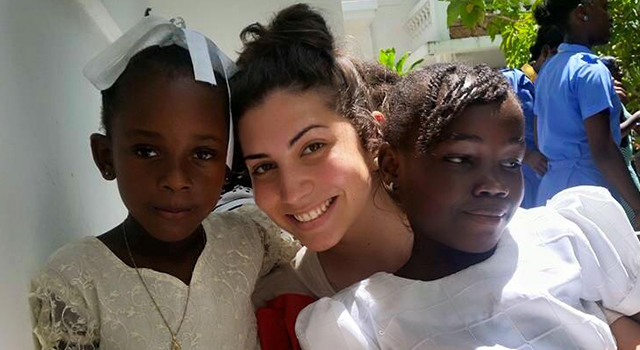By Blanca Morales - Florida Catholic
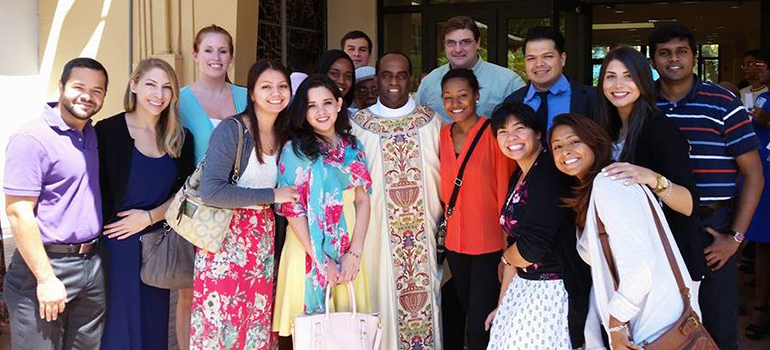
Photographer: COURTESY | Jorge Preble
Members of the summer mission trip teams attend Mass at Notre Dame D'Haiti in Miami's Little Haiti neighborhood. At the center is the church's pastor, Father Reginald Jean-Mary. The team then proceeded to eat at a nearby Haitian restaurant.
Florida Catholic correspondent and Let's Talk blogger Blanca Morales traveled in May with 10 others from St. Augustine Church and Catholic Student Center on a mission trip to Haiti. Here is her report.
PORT-AU-PRINCE | "Why Haiti?"
Many people ask this upon hearing that several groups of young adults travel every year to this Caribbean nation for missionary service.
Many look at this opportunity skeptically, suggesting that I attend a mission trip to Latin America instead, where "at least you’ll know the language."
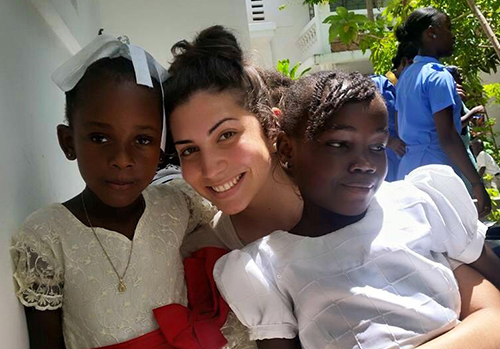
Photographer: COURTESY | Carolina Ulloa
Carolina Ulloa, a young adult from St. Augustine Church and Catholic student center, hangs out with children from Pte. Rivière-de-Nippes, in the Diocese of Anse-a-Veau, after Sunday Mass. "God allowed me to see and experience what truly breaks his heart through serving those in need," she said of her mission experience. "(These) beautiful smiles will be with me forever."
Long recognized as the poorest country in the Western Hemisphere, Haiti undeniably faces many challenges. As my group drove through the capital, one person described it as a "war zone," where the ruins of the 2010 earthquake still lay in dusty mounds.
But the country is not without hope, either.
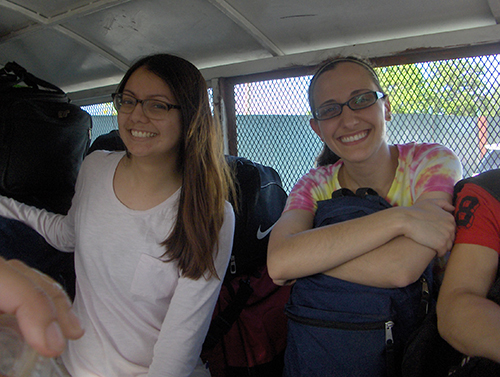
Photographer: BLANCA MORALES | FC
Arriving in Haiti: Rhea Oligario and Liz Kraus sit among bags of donations in a covered truck on the way to the Missionaries of Charity complex in Delmas.
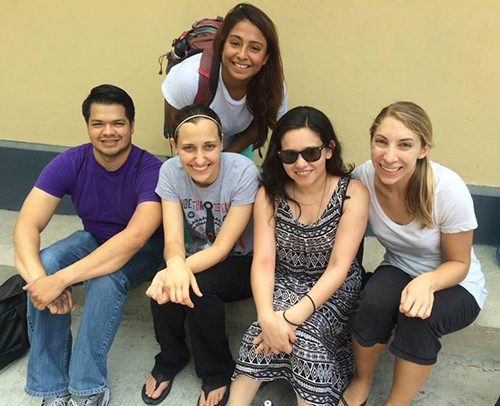
Photographer: COURTESY | Blanca Morales
Members of the first team to Haiti pose for a photo at the Missionaries of Charity hospital complex in Port-Au-Prince. From left: Moises Pineda, Vanessa Santas, Liz Kraus, Blanca Morales and Kristen Morello.
Many of the city’s mothers and fathers have found a beacon of light at the Missionaries of Charity children’s hospital in the neighborhood of Delmas, where malnourished infants and young children are admitted to receive food and medical treatment.
The sisters, many of them doctors or nurses, are joined by volunteer physicians and an army of local Haitian women who feed, change, and care for hundreds of children.
The South Florida volunteers come from two churches and the Catholic Student Center in the St. Augustine area, plus Florida International University and the University of Miami. They go on one- or two-week mission trips to work alongside the Missionaries of Charity, LifeTeen or Haiti180.
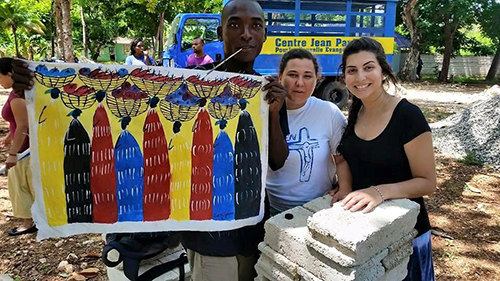
Photographer: COURTESY | Carolina Ulloa
A local artist shows off his work depicting every day life in Haiti.
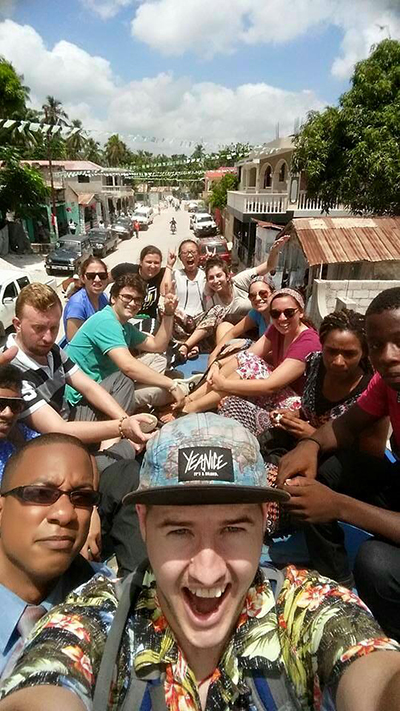
Photographer: COURTESY | Carolina Ulloa
A second team of young adults and college students traveled to Miragoane to work alongside LifeTeen Missions in the Anse-a-Veau diocese. Here they are shown riding in the open on a tap-tap. Tap-taps are colorfully painted trucks or buses used as taxis in Haiti. Most of them have religious slogans and images painted on them.
Our group arrived to assist the caregivers, carrying, feeding and playing with babies who spend all day in cribs.
At first glance, the work seems easy. It was a joy to carry and cuddle babies, though there were moments that required patience and sacrifice, especially when a crying child cannot be quieted. They may be crying out of pain or discomfort, from homesickness, or the depression that often accompanies malnourishment.
Cradling a feverish child can become overwhelming in the sweltering heat of the un-air-conditioned rooms. At times, all one can do as a volunteer is hold a child close to let him know he is not alone.
We quickly learned the literal meaning of compassion: "to suffer with." It’s difficult to see a child suffer from hunger, when in America the solution can be as simple as reaching for a bottle of Pediasure. A nurse practitioner in our group, who works at a South Florida children’s hospital, found the medical treatment in Haiti archaic and lacking in resources.
Signs of undernutrition were severe. We met a little girl named Marie who arrived swollen due to lack of protein. The solution for her, as well as for many of the children, was as simple as food and clean water. Within a few days, the swelling decreased to reveal a smiling, sweet-tempered child who had a girlish affinity for the color pink and for glittery donated flip-flops.
Each day at one of our three-hour shifts, the babies would wait for us to come in, their little faces peeking over the cribs. I remember a little boy, about 2 years old, who swayed happily on Sunday after receiving a juice box — a rare treat. Though his face was also swollen, his ears infected and his skin afflicted, he was a handsome and sweet child.
As he walked over to where we sat with the infants, I jokingly asked him in Creole to share his juice with me. Most 2-year-olds I’ve seen in the U.S. would hug the item to themselves and say their favorite word, "No!" But this little boy cheerfully offered his juice.
"It struck me how quickly we formed such strong bonds with these children within a short week, how much trust they placed in us though strangers to them, and how they recognized the love we desired to give them through our service," said Janis Sanchez, one of the participants on the trip.
While they are indeed thankful for the little we did for them, it is we who appreciate them for letting us see how much we need to grow in faith, hope and charity.
Non-Haitians may be quick to point out atrocities that happen in Haiti, but few see the beauty of the country. Haitian mothers are brave and strong, willing to sacrifice distance — many walking to the hospital without shoes — to visit their children.
One woman I met was well-read and multilingual. She learned Spanish in the Dominican Republic and carried with her a French newspaper and a French Bible, which she used to pray with the 8-month-old daughter she visited.
As she gave her baby a bottle of milk, she saw another infant, a thin 9-month-old the size of a 3-month-old, watching thirstily. The mother took her child’s bottle and gave the remaining portion to the neighboring baby.
"Surrounded by such selflessness, both on the part of the missionaries and the lovely souls we came to serve, I got a glimpse of personhood, of human identity," said Jorge Preble, a fellow volunteer.
Our Creole was limited to a few words and phrases, but the visitors at the hospital were happy to sit with us. Although conversation was difficult, smiles, hand signals and facial expressions aided in communication, and when all else failed, laughter proved to be a common language. I made new friends in the mothers who visited, many of whom were about my age.
Next to the mission complex is a concrete ravine into which flows trash of all kind. We were told that Haiti does not have a garbage system, and ravines like this one are used instead. A missionary family from Chicago, our upstairs neighbors at the guest house, dubbed this canal "The River Rancid," a name suggested by its putrid smell.
Along the mucky banks of the River Rancid live families in one-room shacks whose children attend the primary school at the mission complex. On Sundays, the students’ families joined the children for Mass. We were impressed to see the reverence given to Mass by the people of the neighborhood.
Everyone came in his or her Sunday best — even if it happened to be their first Communion outfit, or their school uniform. Boys wore clean though faded dress shirts tucked into oversized slacks. Girls wore dresses and had their hair braided. If a child got antsy or playful during Mass, a parent or teacher was quick to ensure proper reverence.
Some of us on the mission trip saw Christ in the faces of the children: They looked up into our eyes as if we were the most wonderful person they had ever seen. Others saw Christ at the wound clinic in the outskirts of the city, another work of the Missionaries of Charity.
The clinic was the most challenging experience for us. A long line of people came in with gaping wounds that revealed muscle, tissue or bone. The sight and smell of rotting flesh was overwhelming. More remarkable than these gashes, however, were the smiles of the wounded, their patience with our inexperience, and the way they helped one another apply bandages.
One member of our team imagined himself cleaning Christ’s wounds, and made sure to do so gently and carefully, as he would have done for Christ himself. When I assisted Sister Dani Jesu — a name meaning "Flower of Jesus" in her indigenous language in Mexico — I saw in her Christ’s love as she smiled and worked diligently.
Though she is a nurse, she told us of her first days in Haiti and the shock she experienced at the wound clinic. She would become nauseated; another sister fainted on site. It took weeks for her to get accustomed to the sights and smells.
It isn’t our place to judge or pity the people in Haiti. Their joy, warmth, perseverance and reverence for Mass were exemplary. Perhaps they did more for us than we did for them. They showed us that happiness does not depend on material gain but on what is priceless: unwavering faith, love for neighbor, and hope in the midst of trial.
If we share about what we did or experienced, it is not to sing our own praises, but to indicate that just a two-hour plane ride from here lies a country whose people deserve to know they are loved.
Some have asked: Would I go back? My answer has been yes. It’s worth it. They’re worth it.
Haiti's suffering, by the numbers
- 80 percent of the population lives below the poverty line.
- 54 percent live in abject poverty.40 children die every hour from hunger-related illness.
- 50 percent of Haitian children never make it past their 15th birthday.
- 45 percent of deaths in the country are children aged five and under.
- Malnutrition is manifested by enlarged bellies, cracked skin, rashes, developmental delay, swelling or stunted growth. A malnourished child has a smaller heart, which has to work twice as hard, and their livers are greatly affected, resulting in infections.
